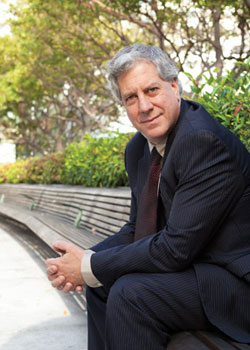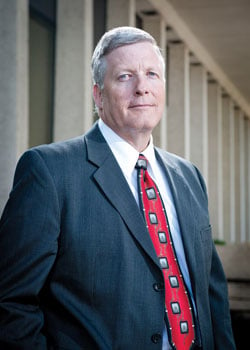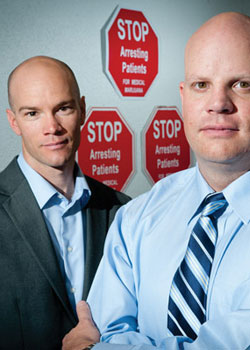Up In Smoke: Voter Reactions Have Some Saying It's Time to Rethink Cannabis Regulation

Kind for Cures is among more than 400 dispensaries targeted by a Los Angeles ordinance. (Photo by Jonahlight.com)
Approach the squat, green-and-white building at a busy corner in the Los Angeles neighborhood of Palms, and you might be tempted to order two pieces of Original Recipe. On closer inspection, one sees that what used to be a Kentucky Fried Chicken store is no longer, and that KFC now stands for “Kind for Cures.”
Kind for Cures sports a green cross in the window and offers medical marijuana to Californians with valid physician recommendations. But whether Kind for Cures is legal depends on whom you ask.
(See related sidebar “Medical Marijuana Is No Get-Rich-Quick Scheme.”)
Jane Usher, a special assistant attorney in the Los Angeles City Attorney’s Office, says that Kind for Cures has “no right to operate in Los Angeles,” under a 2010 city ordinance that limited the number of medical marijuana collectives in the city and set strict controls for their operations. Kind for Cures did not respond to inquiries from the ABA Journal. But its Facebook page and website suggest it is still in operation between 10 a.m. and midnight daily, dispensing products with names like Kona, South Park Kush and Train Wreck. It accepts bank debit cards, MasterCard and Visa.
In some ways, Kind for Cures is the perfect progeny of a 14-year-old California law intended to provide legal cannabis for those suffering painful or debilitating disease. Whether this particular dispensary serves a medically necessary purpose to an actual, underserved patient base is open to question. Where and how it gets its colorfully named product is unknown to those who are supposed to regulate it. And whether it is operating legally—or at all—is left open to speculation, even by those who are responsible for its operation.
In the November elections, Californians rejected Proposition 19, which would have been the first statewide legalization of marijuana in the U.S. If passed, the law would have allowed individuals to use and possess small amounts of marijuana for personal use. Some have argued that passage of Prop 19 would have led to a much wider legalization of drugs that—along with promises of regulation and taxation —could have unintended consequences for public health and law enforcement.
Whether the California vote is a bellwether for the rest of the country’s attitudes on marijuana—for medicinal and recreational use—remains to be seen. But if the November elections are any indication, support for marijuana seems to be waning. In addition to the failure of Proposition 19, voters in Oregon and South Dakota rejected medical marijuana initiatives. And in Arizona, voters passed a compassionate-use law by a very slim 50.13 percent.
Nonetheless, what happens in California is often cited as a precursor to changes in attitude and policy in other states. But if California’s experience is any measure of the future, those who argue for a more liberal marijuana drug policy based on regulation, taxation and medical efficacy may be in for a bumpy ride.
California was the first of 14 states and the District of Columbia to legalize the use of marijuana with a physician’s recommendation. With the exception of D.C. and New Jersey, qualified individuals in those states can grow their own plants for personal use. Several states, including California, allow patients to obtain medical marijuana from licensed collectives that grow the plants for medical use.
But from almost any point of view, California’s regulation of medical marijuana has produced a maze of such differing rules and standards that in some areas of the state medical marijuana dispensaries are as common as convenience stores, while in others, even a bona fide patient genuinely in need of medical marijuana would be hard-pressed to locate any source at all.
Oakland, for instance, is the home of Oaksterdam University, which boasts of offering individuals “the highest-quality training for the cannabis industry.” Last year Oakland assessed a tax on marijuana, and the city estimated that the voter-approved measure would bring $294,000 in additional revenue. In July, the Oakland City Council approved a plan to license four production plants to grow, package and process marijuana.
In San Francisco, the city’s public health department requires that baked goods with marijuana be individually wrapped and labeled, listing the exact amount of drug in the concoction.
Meanwhile, in Orange County, Anaheim lawmakers took the position that federal law prohibiting marijuana use allows cities to ban the marijuana collectives that produce and distribute the drug.
The Qualified Patients Association, an Anaheim medical marijuana group, sued the city in 2007, arguing that the ban violates the state’s Unruh Civil Rights Act. An Orange County Superior Court judge dismissed the case, Qualified Patients Association v. City of Anaheim, finding that the federal law on marijuana trumps state law. California’s Fourth District Court of Appeal overturned that ruling in August, but it also noted that while the Unruh act prohibits discrimination based on medical conditions, the act only applies to businesses. The case was sent back to Orange County Superior Court for a new trial.
And earlier this year, the city of Los Angeles limited to 70 the number of medical marijuana dispensaries allowed and established rules intended to create tighter supervision over medical marijuana distribution and use in the city. The January ordinance, which was in response to the proliferation of dispensaries and complaints about lack of oversight from some groups, also set tighter standards on where they could be located.
By some estimates, the city closed down more than 400 dispensaries this year for violating the new city ordinance.
PATCHWORK PROCESS
If that sounds like local governments are making up the rules as they go along, that may well be correct, says Robert Mikos, a professor at Vanderbilt University Law School who has authored a forthcoming article on the uncertain status of federal marijuana law for the Stanford Law & Policy Review.

Matt Kumin: “What we see … is really silly regulation that puts police chiefs in charge.” (Photo by Melissa Barnes)
“One of the interesting things about the California experience with medical marijuana is that no one has any idea how many medical dispensaries are out there,” says Mikos. “California is only now getting around to try and regulate those.”
Federal laws still dictate enforcement against marijuana production, possession or distribution. But Mikos says that a lack of coherent federal regulation—as opposed to rudimentary law enforcement—has created an uneven scheme of state regulation that has resulted in widely varied and, in most cases, inadequate approaches. “There aren’t that many regulations on the books,” Mikos says. “As far as we can tell, there’s no mechanism in place to make sure that the regulations states do have are being followed.” California voters first authorized the medical uses of marijuana in a 1996 ballot initiative called the Compassionate Use Act. The state’s current regulatory scheme—such as it is—grew from legislation known, even today, as SB 420.
The new state regulation defined the specific maladies that would qualify a California medical patient as an authorized user of marijuana, among them: AIDS, cancer, glaucoma and cachexia—a muscular deterioration widely associated with cancer and AIDS. But the bill also authorized marijuana to relieve more widely assessed conditions like arthritis, muscle spasms, nausea and chronic pain.
The law also created the medical marijuana identification card program, administered through county departments of public health. But participation is voluntary, and patients with physicians’ recommendations can get medical marijuana without an ID card. Although federal law also forbids doctors to “prescribe” marijuana use, California’s state law—like those of other states—requires doctors to “recommend” the use of marijuana for medical purposes.
But instead of setting statewide standards, SB 420 allows counties and municipalities to set their own standards and rules, in effect, for patients, dispensaries and producers of cannabis for medical use. Moreover, local governments control zoning, building permits and occupancy standards that can regulate medical not-for-profit groups, which are the only entities allowed to operate under the medical marijuana laws.
“I would say that the state law is broad and speaks in generalities,” says William L. Pettingill, a senior deputy with the San Diego Office of County Counsel. “So in terms of providing guidance to what we could do with local regulation, it gave us only general parameters in which we could operate.”
The law is likewise vague for those who want to produce or dispense marijuana, and as a result has led to litigation between regulators, dispensers, producers and their patients/clientele as to whether the control of marijuana is a law enforcement or public health issue.
In 2008, for instance, the California Attorney General’s Office issued 11 pages of guidelines, as directed by SB 420, for medical marijuana “collectives and cooperatives.” The guidelines note that California law doesn’t define “collectives,” and uses the Random House unabridged dictionary description, which defines a collective as “a business, farm, etc., jointly owned and operated by the members of a group.”
Medical marijuana groups must file articles of incorporation with the state and conduct business for the mutual benefit of members. The guidelines note that medical marijuana transactions are taxable, and collectives and cooperatives need various licenses and permits. They also note that entities should not buy or sell marijuana from nonmembers.
But nothing in California law requires that medical marijuana collectives disclose where they get their product, and that has created significant tension between law enforcement, state regulation and personal medical privacy.
“I think the state of California overlooked one significantly gaping hole when they wrote SB 420—that was regulation of the source of the product,” says Usher of the Los Angeles City Attorney’s Office. “Until you regulate the source and quality of the product, we have become a welcome mat for the drug cartels.”
Matt Kumin, a partner with San Francisco’s Kumin Sommers, represents a group of Los Angeles medical marijuana users who in May filed a state court class action challenging the city’s recent efforts to shut down many of the existing marijuana dispensaries. The lawsuit challenges city efforts to identify and regulate those who grow and distribute medical marijuana as a violation of the constitutional right of association.
The action also challenges the ordinance requirement that collectives applying for mandatory Department of Building and Safety approval provide the names, telephone numbers and addresses of each collective member engaged in management that, under the ordinance, can be viewed by police without obtaining a search warrant, subpoena or court order.
And the action challenges the ordinance requirement that collectives maintain records of patient members, which, with the exception of medical records, police can view without a search warrant, court order or subpoena.
A PUBLIC HEALTH ISSUE OR A PUBLIC NUISANCE?
Kumin says such a registry for cannabis use in Los Angeles is a precondition not required for use of other medications. A more appropriate regulation, he suggests, would treat medical marijuana collectives like pharmacies, with laws to prevent theft and abuse of prescription medicines.

Matt Cook oversees Colorado’s medical marijuana regulation (Photo by McCory James)
“What we see instead is really silly regulation that puts police chiefs in charge, and it’s not a police issue,” Kumin adds. “It’s a public health issue.”
Usher notes that pharmacies must maintain logs of prescriptions, and the information is transmitted to the Drug Enforcement Administration on a regular basis. If the presumption is that marijuana has medicinal properties, why should there be an objection to registry requirements?
Karen O’Keefe, director of state policies for the Marijuana Policy Project in Washington, D.C., says many of the state laws on medical marijuana vary. Many are designed to protect the patient-user, but also are vague about the source of the marijuana.
“Most state laws are also written to protect a patient who ‘acquires’ marijuana so that they can obtain it from any source legally, though the seller is not protected—unless they’re a caregiver or dispensary operating in accordance with the law,” says O’Keefe.
In some states, like California and Colorado, a primary caregiver is a designated individual who has a consistent responsibility for the patient’s housing, health and safety. In other states, like Montana and Michigan, she says, the caregiver can be someone responsible for assisting a specific patient with the acquisition, cultivation and use of marijuana.
California’s Compassionate Use Act only protected marijuana cultivation by qualified patients and caregivers, and to some that was shortsighted. Not all patients who would benefit from the use of marijuana—or their caregivers—would have the ability to grow it. That concern led to SB 420, which allowed patients to “associate … in order to collectively or cooperatively” cultivate marijuana for medical use.
What sounded like a “caregiver model” for medical marijuana distribution—where someone with knowledge of treating ailments with marijuana can provide it to patients with a physician’s recommendation—was rejected in 2008 by the state’s highest court. Roger Mentch, who had been arrested for growing and selling marijuana from his Santa Cruz County home business called the Hemporium, insisted that his role was that of a caregiver precisely because he counseled his small clientele on its use. The California Supreme Court dismissed his logic as “dog-chasing-its-tail absurdity” in the case of People v. Mentch.
But confusion about the nature and role of caregivers and cooperatives in the cultivation and distribution process continues. Pettingill of San Diego has seen a growing number of “storefront dispensaries.” Qualified patients sign paperwork that designates the storefront operator, who they often don’t know, as a primary caregiver, and the patients receive marijuana for cash.
Pettingill wrote San Diego County’s most recent medical marijuana ordinance, which was adopted in June. Under the ordinance, medical marijuana facilities in the unincorporated areas of San Diego County must have an operating certificate. Clearance for that comes when the establishment is in an approved area. Structures must have secure windows, doors and roofs, as well as a 24-hour monitored alarm system.
“The idea was to create regulation for collective facilities that would allow us to verify that what was going on was a true collective effort, as contemplated by state law,” Pettingill adds. “We like to look at the classic hypothetical: Patient A can grow, patient B can’t because he has debilitating back pain. The two get together; both are qualified patients: One can contribute money, and the other can help with labor.”
Some lawyers who represent San Diego collectives say there are no viable locations for collectives that would be allowed under the ordinance. Pettingill says many people, including lawyers, still don’t understand that the ordinance only applies to unincorporated county areas, and that the number of available locations was considered when drafting the ordinance. “How many is enough? There’s no case law on that. You can’t zone them out of existence, but we have no idea what the demand is,” Pettingill says.
REGIONAL MINDSET
California’s uneven medical marijuana experience may have had less to do with coherent regulation than a statewide ambivalence toward the recreational use of marijuana, as revealed in the state’s November vote. But in other states, the debate is more acrimonious than ambivalent.

Brian Vincente and Christian Sederberg head a Denver-based medical marijuana law firm (Photo by McCory James)
In 2008, Michigan voters passed a medical marijuana ballot measure by nearly 63 percent. The law states that a qualified patient, who has been issued and possesses a registration ID card, should not be subject to arrest, or denied any right or privilege, providing that he or she does not possess more than 2.5 ounces of usable marijuana. Possession of marijuana without a physician’s recommendation in Michigan is punishable by up to one year in jail and a $2,000 fine.
Still, many are arrested even if they possess a physician’s recommendation when they appear to be using marijuana under the pretext of medical treatment, says John Targowski, a Kalamazoo criminal defense lawyer.
“A lot of times these people get caught in apartments with a bong on the table, playing video games,” Targowski says. “Some people admit at incident that they like to get high.”
Targowski thinks that law enforcement there is trained to ask questions to determine use.
“In western Michigan you have a very active law enforcement for marijuana,” he says. “People consider marijuana a gateway drug.”
Out of all the states that allow medical marijuana, Colorado seems to have taken what many consider the most practical approach. Medical marijuana there is sold for profit by businesses, and the Colorado Department of Revenue has regulation oversight.
Matt Cook leads the Colorado Department of Revenue’s enforcement group, which includes a medical marijuana division. A former narcotics officer, Cook previously served as director of the Colorado Liquor Enforcement Division. His approach to regulating medical marijuana is similar to the state’s liquor regulation model.
Cook leads a medical marijuana working group of law enforcement, patients, patient advocates, growers, lawyers and representatives from state and local government. The group, which has 30 members, meets twice a month. Cook says that he drafted 92 pages of administrative rules for the working group’s consideration, and that it has approved the majority of what he wrote. Under the rules, the state’s medical marijuana centers can’t modify their premises after they’re licensed, and security cameras are mandatory for centers and grow facilities. The rules also state that center owners and staff can’t touch the security cameras.
Colorado voters approved medical marijuana use in 2000. Lawmakers set new laws this summer, which require that marijuana centers be licensed at both the state and local levels. Local governments, or voters, can ban centers and large-scale marijuana growers from their communities. Centers must grow at least 70 percent of the marijuana they sell, and the law distinguishes between centers and primary caregivers.
Also, physicians must have “bona fide” relationships with clients to whom they recommend medical marijuana.
The legislation, which became law July 1, included a provision that existing marijuana center owners had to apply for a state license by Aug. 1. The 30-page application requested detailed information about the financial history of applicants and their immediate family. Recent felons are disqualified, as is anyone who in the past five years has had a felony drug possession or distribution conviction. At local governments’ request, the state imposed a moratorium on opening new marijuana centers until the summer of 2011.
According to Cook, Colorado has received 809 applications for marijuana center licenses and 309 applications for infused product manufacturing like brownies, oils and tinctures. Additionally, 1,219 permit applications sought “premises cultivation” for growing marijuana. Application fees range from $7,500 to $18,000, depending on the size of the marijuana center, and have thus far yielded $8.2 million.
“This really is a landmark piece of legislation,” says Brian Vicente, a partner with Christian Sederberg in the medical marijuana law firm Vicente Consulting. Vicente also founded and is the executive director of Sensible Colorado, a nonprofit advocacy group for medical marijuana.
“We’ve kind of jumped past California, because we have guidance from the state and we also have communities creating their own regulations,” says Vicente, who practices in Denver.
“We were plagued by uninformed enforcement officers for years, who didn’t know or respect the state medical marijuana law. Now they recognize it’s a government-sanctioned program.”
Last updated on Nov. 29 to reflect final election results.



